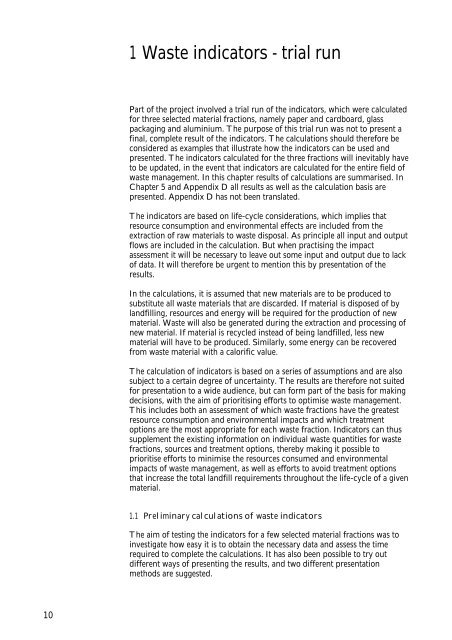Waste Indicators
Waste Indicators
Waste Indicators
You also want an ePaper? Increase the reach of your titles
YUMPU automatically turns print PDFs into web optimized ePapers that Google loves.
1 <strong>Waste</strong> indicators - trial runPart of the project involved a trial run of the indicators, which were calculatedfor three selected material fractions, namely paper and cardboard, glasspackaging and aluminium. The purpose of this trial run was not to present afinal, complete result of the indicators. The calculations should therefore beconsidered as examples that illustrate how the indicators can be used andpresented. The indicators calculated for the three fractions will inevitably haveto be updated, in the event that indicators are calculated for the entire field ofwaste management. In this chapter results of calculations are summarised. InChapter 5 and Appendix D all results as well as the calculation basis arepresented. Appendix D has not been translated.The indicators are based on life-cycle considerations, which implies thatresource consumption and environmental effects are included from theextraction of raw materials to waste disposal. As principle all input and outputflows are included in the calculation. But when practising the impactassessment it will be necessary to leave out some input and output due to lackof data. It will therefore be urgent to mention this by presentation of theresults.In the calculations, it is assumed that new materials are to be produced tosubstitute all waste materials that are discarded. If material is disposed of bylandfilling, resources and energy will be required for the production of newmaterial. <strong>Waste</strong> will also be generated during the extraction and processing ofnew material. If material is recycled instead of being landfilled, less newmaterial will have to be produced. Similarly, some energy can be recoveredfrom waste material with a calorific value.The calculation of indicators is based on a series of assumptions and are alsosubject to a certain degree of uncertainty. The results are therefore not suitedfor presentation to a wide audience, but can form part of the basis for makingdecisions, with the aim of prioritising efforts to optimise waste management.This includes both an assessment of which waste fractions have the greatestresource consumption and environmental impacts and which treatmentoptions are the most appropriate for each waste fraction. <strong>Indicators</strong> can thussupplement the existing information on individual waste quantities for wastefractions, sources and treatment options, thereby making it possible toprioritise efforts to minimise the resources consumed and environmentalimpacts of waste management, as well as efforts to avoid treatment optionsthat increase the total landfill requirements throughout the life-cycle of a givenmaterial.1.1 Preliminary calculations of waste indicatorsThe aim of testing the indicators for a few selected material fractions was toinvestigate how easy it is to obtain the necessary data and assess the timerequired to complete the calculations. It has also been possible to try outdifferent ways of presenting the results, and two different presentationmethods are suggested.10
















